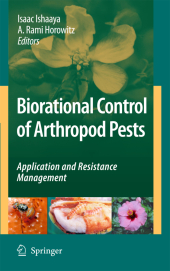 Neuerscheinungen 2014Stand: 2020-02-01 |
Schnellsuche
ISBN/Stichwort/Autor
|
Herderstraße 10
10625 Berlin
Tel.: 030 315 714 16
Fax 030 315 714 14
info@buchspektrum.de |

A. R. Horowitz, Isaac Ishaaya
(Beteiligte)
Biorational Control of Arthropod Pests
Application and Resistance Management
Herausgegeben von Ishaaya, Isaac; Horowitz, A. Rami
2009. 2014. xi, 408 S. 235 mm
Verlag/Jahr: SPRINGER NETHERLANDS; SPRINGER 2014
ISBN: 9400791682 (9400791682)
Neue ISBN: 978-9400791688 (9789400791688)
Preis und Lieferzeit: Bitte klicken
Various approaches for arthropod pest control is the subject of this book. Among the highlights of the book is the use of selective control agents acting on specific biochemical sites. Another highlight is the novel biotechnology control strategies discussed.
For nearly 50 years, pest control was mostly based on broad-spectrum conv- tional insecticides such as organochlorines, organophosphates, carbamates and pyrethroids. However, the severe adverse effects of pesticides on the environment, problems of resistance reaching crisis proportions and public protests led to stricter regulations and legislation aimed at reducing their use. Ways to reduce the use of synthetic pesticides in plant protection and to use more alternative and novel me- ods for pest control or biorational control are the challenges of pest control for the twenty-first century. The term biorational (biological + rational) pesticides can be defined as the use of specific and selective chemicals, often with a unique modes of action, that are compatible with natural enemies and the environment, with minimal effect on n- target organisms. Biorational control is based on a diversity of chemical, biological and physical approaches for controlling insect pests which results in minimum risk to man and the environment.
Biorational Pest Control - An Overview.- Agonists/Antagonists of the Insect Kinin and Pyrokinin/PBAN Neuropeptide Classes as Tools for Rational Pest Control.- Rational Design of Insect Control Agents: The PK/PBAN Family as a Study Case.- Tyramine and Octopamine Receptors as a Source of Biorational Insecticides.- Recent Advances in the Mode of Action of Juvenile Hormones and Their Analogs.- ?-Aminobutyric Acid Receptors: A Rationale for Developing Selective Insect Pest Control Chemicals.- Natural Products: Plant Lectins as Important Tools in Controlling Pest Insects.- Genetically Modified Insects as a Tool for Biorational Control.- Symbiosis Research as a Novel Strategy for Insect Pest Control.- Novel Approaches for the Management of Mealybug Pests.- Manipulation of Insect Signaling for Monitoring and Control of Pest Insects.- Physical Control: An Important Tool in Pest Management Programs.- A Systems Approach to IPM Integration, Ecological Assessment and Resistance Management in Tree Fruit Orchards.- Mechanisms of Acaricide Resistance in the Two-Spotted Spider Mite Tetranychus urticae.


